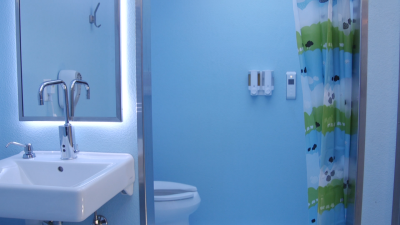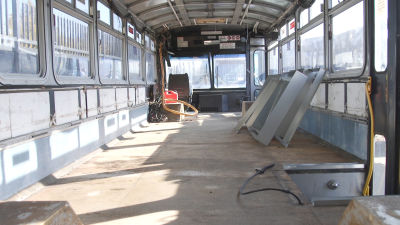It all started in 2012 when Doniece Sandoval overheard a homeless woman on the street crying that she would never feel clean again. Sandoval took this lament to heart and decided she wanted to do something to help. So she began doing some research to see how accessible showers were for San Francisco’s homeless population.
“There were about 16 shower stalls for 3,500 men, women and children who literally live on the streets,” she explains. “And I thought that’s crazy, this isn’t a third world country, yet here in San Francisco, one of the most affluent cities in the world, we have issues with access to water and sanitation.”
Not long after this discovery, she founded Lava Mae, a non-profit organization that takes retired public transportation buses and converts them into mobile hygiene units for the homeless. In June of 2014, they launched their pilot bus. Fire hydrants provide the buses with water-- a hose and water meter connect the fire hydrant to the bus, ensuring that Lava Mae is billed for the water they use. They also have a special agreement with the city of San Francisco that allows them to drain the shower water into the sewers. Storage tanks underneath the bus collects sewage from the toilets, which then gets transported to a treatment facility.

Lava Mae’s mobility allows them to partner with other homeless service organizations, and they pull their shower bus in front of those locations. This allows users to sign up for a shower time, so they can avoid waiting in a physical line, and, if they choose, users can utilize some of the services that their partner organizations offer. By going mobile, Lava Mae does not have to worry about losing their shower facilities to rising rent in San Francisco, and they can serve multiple areas instead of being restricted to just one location. While the buses offer these advantages over stationary shower stalls, actually converting the old buses into showers was quite a design and engineering challenge.
One of the biggest challenges was maintaining the structural integrity of the bus-- making sure that the bus won’t tip or fall over when taking turns or going up and down the hills of San Francisco. Making changes to the bus, like creating skylights and adding water storage tanks, can affect the stability of the bus. Converting these buses required a very careful design. Sandoval solicited the help of Brett Terpeluk, an architect. Part of the design process involved reaching out to the homeless community and running focus groups to determine user needs. The team realized very quickly that they wanted to create private, safe spaces in which people could shower. Given the size of the bus, that meant that they could only fit two bathrooms on the bus, each with a private shower, sink, toilet and changing area. They also wanted to ensure that one of the bathrooms was accessible by wheelchair and to those with disabilities.
